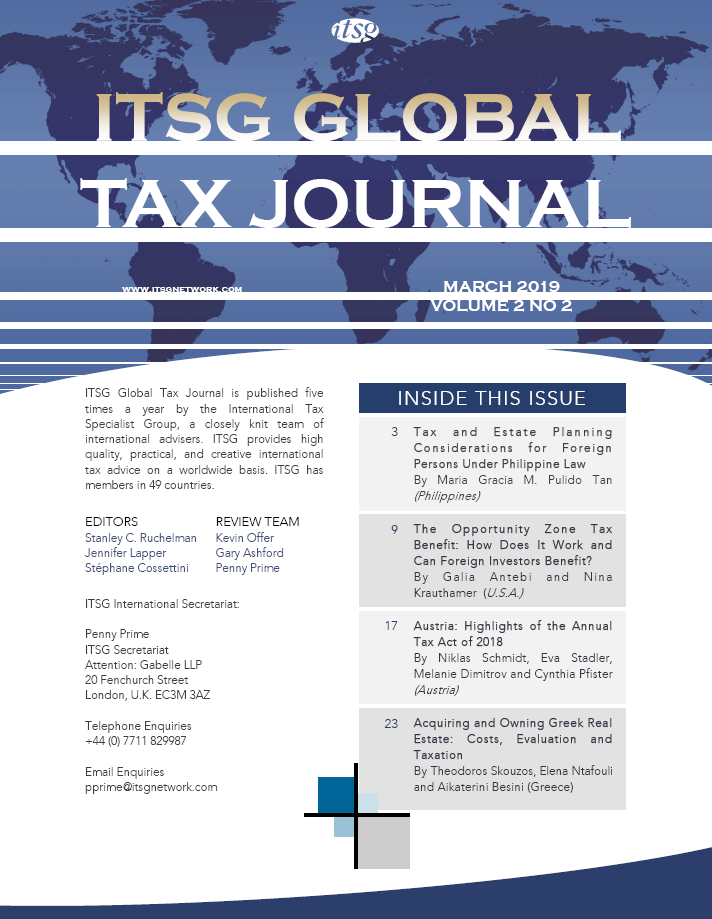Introduction
The Annual Tax Act of 2018 (Jahressteuergesetz) is mainly aimed at implementing Council Directive (E.U.) 2016/1164 of 12 July 2016 into Austrian law. This directive sets out rules against tax avoidance practices that directly affect the functioning of the internal market and is generally referred to as the Anti-Tax Avoidance Directive (A.T.A.D.). The Annual Tax Act of 2018 also strives to strengthen legal and planning security and to combat tax fraud on a national and international level. This article provides an overview of the most important amendments emanating from this act.
C.F.C. Rules
The A.T.A.D. specifies that Member States are to enact controlled foreign company (C.F.C.) rules. Previously, Austria did not have any C.F.C. legislation. Following the Annual Tax Act of 2018, C.F.C. rules apply from 1 January 2019. Pursuant to the C.F.C. provisions, non-distributed passive income of a low-taxed C.F.C. (wherever resident) is to be included in the tax base of the controlling corporation if the following prerequisites are fulfilled:
- The passive income of the C.F.C. exceeds a third of its total income (the income is to be calculated in line with Austrian tax provisions, whereby tax-exempt dividends and capital gains are included when calculating the total income).
- The controlling corporation, alone or together with its associated enterprises, holds a direct or indirect participation of more than 50% of the voting rights or owns directly or indirectly more than 50% of the capital or is entitled to receive more than 50% of the profits of the C.F.C.
- The C.F.C. does not carry out a substantive economic activity supported by staff, equipment, assets, and premises (in cases where a substantive economic activity exists, the controlling corporation must furnish proof thereof).
Passive income encompasses the following types of income:
- Interest or any other income generated by financial assets;
- Royalties or any other income generated from intellectual property;
- Dividends and income from the disposal of shares, insofar as these would be taxable at the level of the controlling corporation;
- Income from financial leasing;
- Income from insurance, banking, and other financial activities; and
- Sales and/or services income generated by invoicing companies from goods and services purchased from and sold to associated enterprises, which add no or little economic value.
A foreign company is low-taxed if its effective foreign tax rate is not more than 12.5%. In order to determine the effective foreign tax rate, the foreign company's income is to be calculated in line with Austrian tax provisions and compared with the foreign tax actually paid.
For purposes of the C.F.C. rules, an associated enterprise exists if:
- the controlling corporation holds directly or indirectly a participation in terms of voting rights or capital ownership of at least 25% in an entity or is entitled to receive at least 25% of the profits of that entity; or
- a legal person or individual or group of persons holds directly or indirectly a participation in terms of voting rights or capital ownership of at least 25% or is entitled to receive at least 25% of the profits of the corporation (if a legal person or individual or group of persons holds directly or indirectly a participation of at least 25% in the corporation and one or more entities, all the entities concerned, including the corporation, shall also be regarded as associated enterprises).
Where the C.F.C. provision applies, the amount of the C.F.C.'s passive income to be included in the tax base of the controlling corporation is calculated in proportion to the (direct or indirect) participation in the nominal capital of the C.F.C. If the profit entitlement deviates from the participation in the nominal capital, then the profit entitlement ratio is decisive. The passive income of the C.F.C. is included in the financial year of the controlling corporation in which the C.F.C.'s financial year ends. C.F.C. losses, if any, are not includable.
In order to prevent double taxation, the following rules apply:
- A C.F.C.'s passive income is not to be included in the tax base of a controlling corporation which only holds an indirect participation in the C.F.C. in cases where such passive income is already included in the tax base of an Austrian controlling corporation holding a direct participation in the C.F.C.
- If the controlling corporation disposes of its participation in the C.F.C., any capital gains are tax exempt insofar as they have previously been included in the controlling corporation's tax base.
- When including the C.F.C.'s passive income in the controlling corporation's tax base, upon application, the tax effectively levied on such passive income at the level of the C.F.C. is credited, as is passive income included at the level of the C.F.C. due to comparable foreign C.F.C. legislation. If the foreign tax to be credited exceeds the controlling corporation's Austrian corporate income tax, tax credits can, upon application, also be claimed in the following years.
The C.F.C. rules also apply to Austrian corporations having their place of management outside of Austria and to foreign permanent establishments (even if an applicable double tax treaty provides for a tax exemption in Austria).
In the absence of the C.F.C. rules, the Austrian tax system previously prevented taxpayers from transferring excess liquidity to low-taxed foreign subsidiaries and from repatriating the resulting income in a tax-free manner through the so-called switch-over provision: Dividends and capital gains from low-taxed passive income earning subsidiaries could not benefit from the international participation exemption but were taxable, with a credit for any underlying taxes. (Thus, there was a switch from the exemption to the credit method.) This switch-over provision is still applicable to the following types of participations if the predominant focus of the low-taxed foreign corporation is on earning passive income:
- Shareholdings of at least 10% held for a minimum duration of one year in a foreign subsidiary qualifying under the E.U. Parent Subsidiary Directive or being legally comparable to an Austrian corporation
- Shareholdings of at least 5% in a foreign subsidiary qualifying under the E.U. Parent Subsidiary Directive or in a foreign subsidiary being legally comparable to an Austrian corporation and having its legal seat in a state with which Austria has agreed to the comprehensive exchange of information
The switch-over provision does not apply if passive income has demonstrably been taken into account under the C.F.C. provision mentioned above.
Both the C.F.C. rules and the switch-over provision will not be applicable to foreign financial institutions if not more than one-third of the passive income stems from transactions with the Austrian controlling corporation or its associated enterprises.
Implementation of the interest limitation rule contained in the A.T.A.D.
The A.T.A.D. further requires Member States to implement an interest limitation rule in their domestic laws. Pursuant thereto, the tax deductibility of net interest (i.e., interest expense minus interest income) shall be limited insofar as it exceeds 30% of the taxpayer's E.B.I.T.D.A. (earnings before interest, tax, depreciation, and amortisation). In general, this rule should have been implemented by 31 December 2018. However, Member States which have national targeted rules for preventing base erosion and profit shifting (B.E.P.S.) risks as of 8 August 2016, which are equally effective to the interest limitation rule set out in the A.T.A.D., may delay the implementation of the interest limitation rule until 1 January 2024 at the latest.
For several years already, Austrian tax law has provided for non-deductibility of interest paid to a corporation if the payer and recipient are, directly or indirectly, part of the same group, or have, directly or indirectly, the same controlling shareholder, and the interest paid at the level of the recipient (or the beneficial owner, if different) is:
- Not subject to corporate income tax owing to a comprehensive personal or material tax exemption;
- Subject to corporate income tax at a rate of less than 10%;
- Subject to an effective tax rate of less than 10% owing to an applicable reduction; or
- Subject to a tax rate of less than 10% owing to a tax refund (refunds to the shareholder are also relevant).
This Austrian non-deductibility rule was implemented in the wake of the O.E.C.D.'s first steps against B.E.P.S. It is probably for this reason that the Austrian Ministry of Finance believes that Austria already has equally effective rules allowing Austria to delay implementation of the 30% E.B.I.T.D.A. rule. Austria has not, therefore, implemented the A.T.A.D. interest limitation rule.
The European Commission recently published a list of Member States which, in its view, fulfil the requirements as per art. 11(6) of the A.T.A.D. (cf. Commission Notice 2018/C 441/01). When drawing up the list, the European Commission assessed the legal similarity and the economic equivalence of measures notified by Member States:
- The basic assumption for the examination of legal equivalence was that only measures which ensure a limitation on the deductibility of excessive borrowing costs in relation to a taxpayer's profitability may be primarily regarded as equally effective in targeting excessive interest deductions.
- The analysis of economic equivalence in turn involved two criteria: First, the notified national measure should not produce significantly less revenue than the A.T.A.D.'s interest limitation rule. Second, the notified national measure should lead to a similar or higher tax liability for a majority of large undertakings as compared with the estimated result under the A.T.A.D.
Applying these criteria, the European Commission concluded that specific measures in force in France, Greece, Slovakia, Slovenia, and Spain fall under art. 11(6) of the A.T.A.D. The list, however, does not include Austria, meaning that Austria has, in the European Commission's view, failed to implement the A.T.A.D.'s interest limitation rule. It remains to be seen how the Austrian Ministry of Finance will react.
Exit Tax
The A.T.A.D. obliges Member States to implement exit taxation rules regarding corporations. The Austrian provisions dealing with exit taxation had already been amended some time before the A.T.A.D. was adopted and largely comply with the requirements of the A.T.A.D.
In general, the Austrian exit tax scheme aims to tax hidden reserves of certain assets that accrued while Austria had a taxation right but which can no longer be (fully) taxed in Austria due to circumstances leading to a restriction of Austria's taxation right vis-à-vis other states (such as transfers of business assets abroad).
If the restriction of the Austrian taxation right is in relation to a Member State of the E.U. or a country which is party to the E.E.A., the exit tax can be paid in instalments. Previously, the tax burden could be spread over seven years (for fixed assets) or two years (for current assets). Under the Annual Tax Act of 2018, the taxpayer continues to be able to pay the tax burden in instalments; however, the seven-year payment period for fixed assets is shortened to five years in order to fall within the terms of the A.T.A.D. The instalment period for current assets remains unchanged.
Any outstanding instalment payments are immediately due if assets, businesses, or permanent establishments are alienated, otherwise disposed of, or transferred to a state outside of the E.U. or the E.E.A. In addition to these circumstances, the Annual Tax Act of 2018 includes the following situations that require immediate payment:
- The place of management of a corporation is relocated to a state outside of the E.U. or E.E.A.;
- The taxpayer declares bankruptcy or is wound up; or
- The taxpayer (partly) fails to pay an instalment within 12 months of the due date.
Anti-Abuse Rule
The A.T.A.D. requires Member States to have a general anti-abuse rule in place. As with many other jurisdictions, Austrian tax law has always contained the principle that taxpayers are free to arrange their economic affairs in the manner they deem most beneficial to themselves, which includes choosing those structures and approaches that incur the lowest tax costs. Nevertheless, Austrian law also contains a general anti-abuse provision, pursuant to which a tax liability cannot be avoided or reduced by abusing the legal forms or methods available under civil law. If such an abuse has been established, the tax authorities may compute the tax liability as if the abuse had not occurred. The Austrian Supreme Administrative Court (Verwaltungsgerichtshof) has, in the past, defined abuse of law as a legal structure which has an unusual and inappropriate economic objective and, in the light of the objective of the tax law, can only be understood by virtue of the associated tax savings. Further, the Austrian Supreme Administrative Court has held that abuse of law cannot usually be caused by a single legal step, but rather, it presupposes a chain of legal acts.
Following the Annual Tax Act of 2018, for the first time, a definition of abuse of law has been incorporated into statutory law. According to the guidance accompanying the enactment of the Annual Tax Act of 2018, the chosen wording of the new definition shall not lead to a restriction of the previous scope of abuse of law. It aims at preserving the traditional interpretation as much as possible. However, the definition partly contradicts the previously prevailing understanding of the term. The new definition reads as follows:
Abuse of law is deemed to exist in cases where a legal structure, that may involve one or more steps, or a sequence of legal structuring, is inappropriate in light of the economic purpose. The term ‘inappropriate’ refers to structures that would be rendered meaningless without the tax benefit, as the essential purpose or one of the essential purposes of such structures is to obtain a tax advantage which is contrary to the aim or purpose of applicable tax legislation. However, abuse of law is not existent if there are valid economic reasons that reflect economic reality.
Consequently, contrary to the traditional notion of abuse of law, the newly created definition stipulates that any isolated legal step, and not just a sequence of legal acts, can lead to an abuse of law. Another tightening of the concept is achieved by the fact that abuse of law may already be assumed if only one of several purposes is to obtain a tax advantage. In the past, abuse of law mainly targeted structures where the sole purpose was to obtain a tax benefit. It is to be expected that abuse of law will play a more significant role in tax proceedings in the future.
New types of formal tax rulings
The Annual Tax Act of 2018 introduces new types of formal tax rulings. In general, a tax ruling may be defined as the confirmation by a tax authority of the interpretation of tax law presented by a taxpayer (or his adviser). Previously, legally binding tax rulings (Auskunftsbescheide) could only be obtained in Austria for the following topics:
- Reorganisations;
- Group taxation; and
- Transfer pricing.
The Annual Tax Act of 2018 provides an extension to include the following topics (in addition to the topics mentioned above):
- International tax law (i.e., transfer pricing and tax treaties, but not domestic law provisions, as of 1 January 2019);
- Value added taxation (as of 1 January 2020); and
- The existence of abuse of law in an envisaged structuring (as of 1 January 2019).
In addition, organisational measures will improve the opportunity for the recipient to raise queries to the responsible tax officer in case of ambiguities after the tax ruling has been issued. A tax ruling shall be issued within two months of receiving an application.
Clarification on real estate transfer tax
The Austrian Annual Tax Act of 2018 includes important clarifications on share consolidation in the context of real estate transfer tax (R.E.T.T.). Pursuant to the Austrian Real Estate Transfer Tax Act, R.E.T.T. is triggered not only upon the transfer of Austrian real estate but also if at least 95% of the shares in a property-owning company are transferred or consolidated in the hands of a single owner (or corporations which are part of the same tax group for Austrian corporate income tax purposes). It has been unclear for some time whether only direct share transfers or also indirect share transfers can trigger R.E.T.T.
The Annual Tax Act of 2018 clarifies that real estate is attributed to the company and not to its shareholder. In this way, the Austrian legislator clearly states that changes in indirect shareholding of a property-owning company do not trigger R.E.T.T., since shareholders are not regarded as property owners.
Horizontal Monitoring
The Annual Tax Act of 2018 implements horizontal monitoring for companies as an alternative to the normal audit procedure. Horizontal monitoring has been available since 1 January 2019 upon application by the taxpayer. It differs from external audits in several areas.
Firstly, a uniform audit of a group of companies is possible, which shall facilitate the communication with the tax authorities. Secondly, during the horizontal monitoring, there is an increased obligation to disclose any circumstances for which there is a serious risk of divergent assessment by the tax office, unless such circumstances do not have a significant impact on the tax. Thirdly, there shall be continuous contact between the company and the tax authorities in the form of at least four meetings per calendar year.
An application for horizontal monitoring may be lodged by an entrepreneur or a private foundation holding alone, or together with other private foundations, more than 50% of the share capital and voting rights of an entrepreneur. Further, the following prerequisites must be fulfilled:
- There must be an Austrian nexus in the form of a place of management, legal seat, permanent establishment, or residence in Austria of the entrepreneur and all associated entrepreneurs.
- Each entrepreneur is obliged to keep books in accordance with Austrian law provisions or voluntarily maintains books.
- No entrepreneur has been penalized or fined in the five years preceding the application for a financial offence committed intentionally or through gross negligence in the last seven years prior to the application.
- At least one entrepreneur had, inter alia, revenues exceeding €40 million in the two years prior to the application.
- There is an opinion of an auditor or tax advisor that each entrepreneur has implemented a special tax control system.

 Login
Login





















































